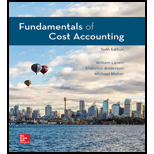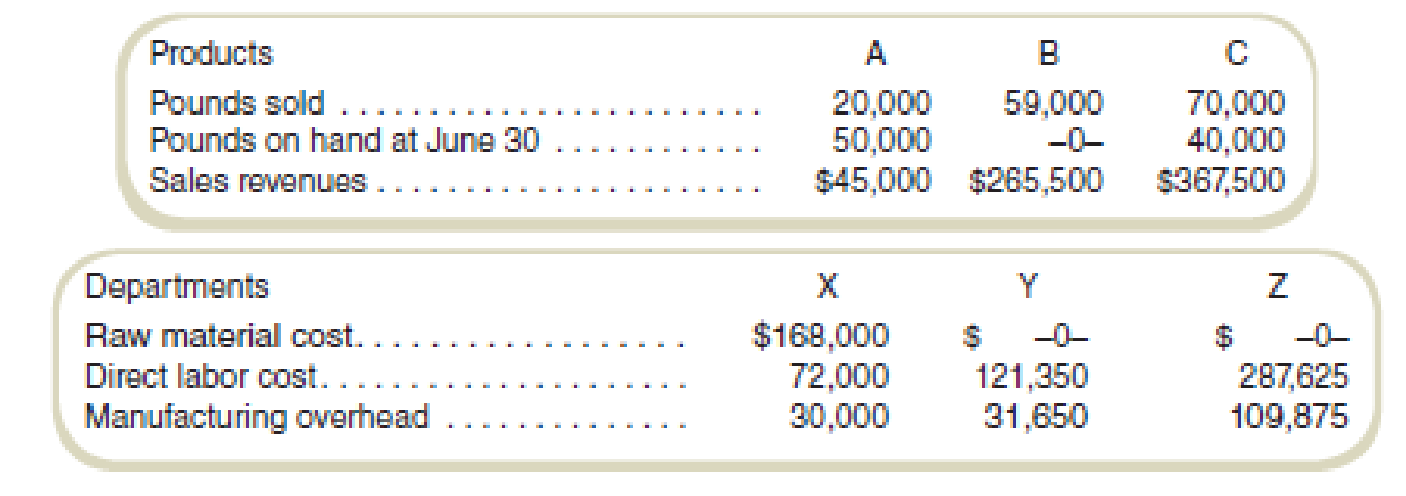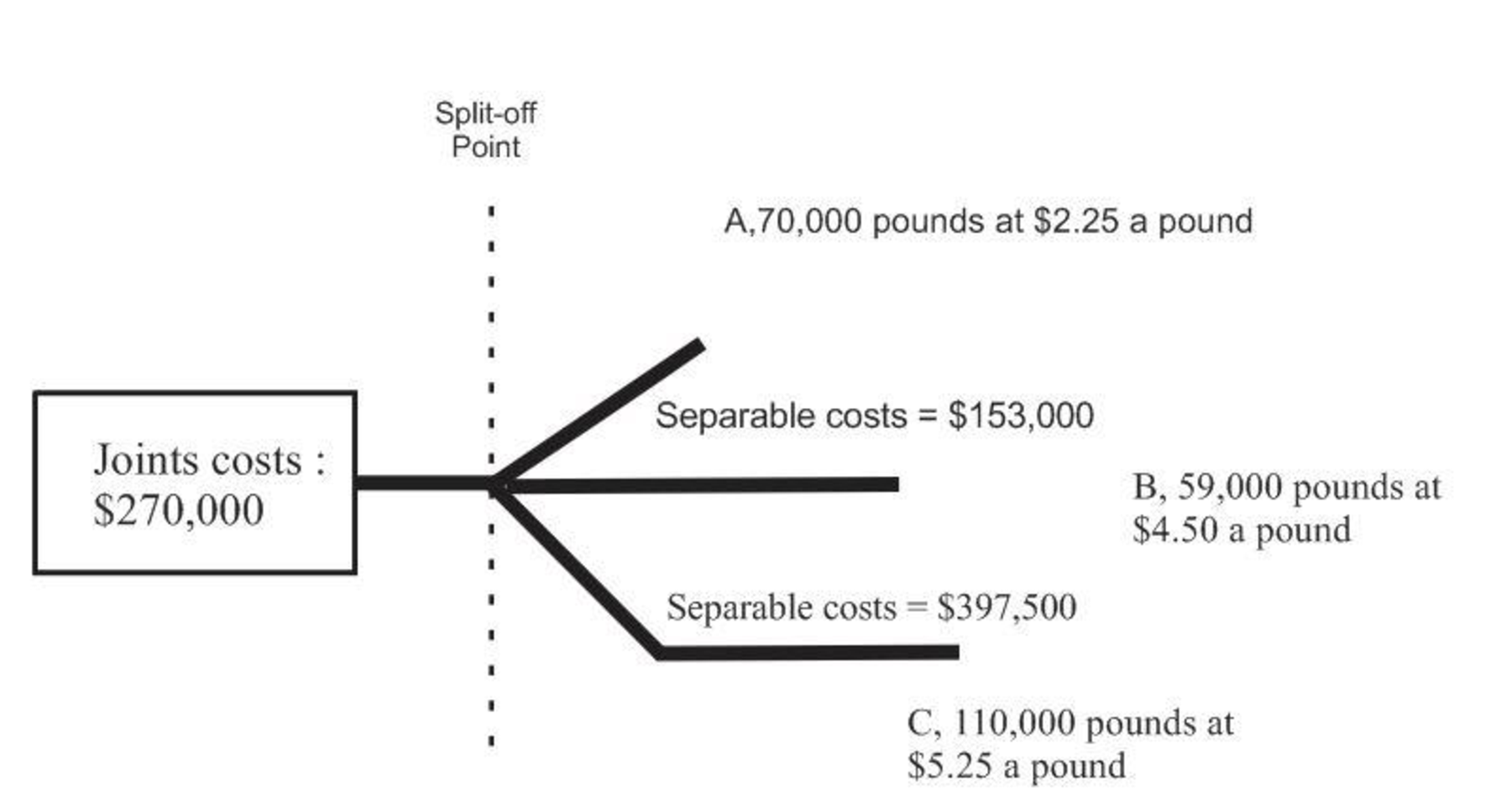
Fletcher Fabrication, Inc., produces three products by a joint production process. Raw materials are put into production in Department X, and at the end of processing in this department, three products appear. Product A is sold at the split-off point with no further processing. Products B and C require further processing before they are sold. Product B is processed in Department Y, and product C is processed in Department Z. The company uses the estimated net realizable value method of allocating joint production costs. Following is a summary of costs and other data for the quarter ended June 30.
No inventories were on hand at the beginning of the quarter. No raw material was on hand at June 30. All units on hand at the end of the quarter were fully complete as to processing.

Required
- a. Determine the following amounts for each product: (1) estimated net realizable value used for allocating joint costs, (2) joint costs allocated to each of the three products, (3) cost of goods sold, and (4) finished goods inventory costs, June 30.
- b. Assume that the entire output of product A could be processed further at an additional cost of $6.00 per pound and then sold for $12.90 per pound. What would have been the effect on operating profits if all of product A output for the quarter had been further processed and then sold rather than being sold at the split-off point?
- c. Write a memo to management indicating whether the company should process product A further and why.
a.
Determine the following amounts for each product:
(1) The estimated net realizable value used for allocating joint costs
(2) The joint costs allocated to each of the three products
(3) The cost of goods sold, and
(4) The finished goods inventory costs, June 30.
Explanation of Solution
Joint cost allocation:
Joint cost allocation allocates the common cost of the various departments of the business. IT, accounting and administration services are utilized by various departments so it should be allocated to the various departments based on the usage of the cost.

Determine the estimated net realizable value used for allocating joint costs:
1.
| Particulars | Product A | Product B | Product C | Total |
| Selling price per pound: | ||||
| A: | $ 2 | |||
| C: | $ 5 | |||
| Pounds produced: | ||||
| A: | 70,000 | |||
| C: | 110,000 | |||
| Gross sales values | $ 157,500 | $ 265,500 | $ 577,500 | |
| Less: Costs of separate processing: | ||||
| A: | $ - | |||
| B: | $ 153,000 | |||
| C: | $ 397,500 | |||
| Estimated net realizable values at split-off point | $ 157,500 | $ 112,500 | $ 180,000 | $450,000 |
| Percentage of total | 35% | 25% | 40% | 100% |
Table: (1)
2.
Determine the joint costs allocated to each of the three products:
Product A:
Product B:
Product C:
Total joint costs:
Thus, the total amount of the joint cost is $270,000.
3.
| Particulars | Total costs | Cost of goods sold | Ending inventory |
| Product A: | |||
| Joint costs allocated | $ 94,500 | ||
| Sold: | $ 27,000 | ||
| Inventory | $ 67,500 | ||
| Product B: | |||
| Joint costs allocated | $ 67,500 | ||
| Separate processing costs | $ 153,000 | ||
| Total of sales | $ 220,500 | $ 220,500 | $ - |
| Product C: | |||
| Joint costs allocated | $ 108,000 | ||
| Separate processing costs | $ 397,500 | ||
| Total costs of Z | $ 505,500 | ||
| Sold: | $ 321,682 | ||
| Inventory | $ 183,818 | ||
| Total | $ 820,500 | $ 569,182 | $ 251,318 |
Table: (2)
4.
Thus, the cost of the finished goods inventory as on June 30 is $569,182.
b.
Identify the effect on operating profits if all of the product A output had been further processed for the quarter and then sold rather than being sold at the split-off point.
Explanation of Solution
Operating profit:
The operating profit is the excess of total revenues over total expenses after adjusting for depreciation and taxes.
Compute the incremental revenue of further processing:
Compute the incremental costs of further processing:
Compute the effect on operating profits:
Thus, the operating profits have been increased by $325,500 when all of the product A output for the quarter had been further processed and then sold rather than being sold at the split-off point.
c.
Prepare a memo to management indicating whether product A should be processed by the company or not.
Explanation of Solution
Memo
From
ABC
To
XYZ
Re: Whether product A should be continued by the management or not.
Dear XYZ,
I am glad to share that Product A is going to bring an additional operating profit of $325,500. So, here I am explaining to you whether Product A should be continued by the management.
Product A:
The incremental revenue arising out of the product is $745,500, and the incremental costs are $420,000. Thus, it results in an extra profit of $325,500.
Thus, the company should continue with product A because it is going to be profitable if it is further processed.
I hope now you are clear about the information I have provided regarding whether the product should be processed or not. You can revert if you need some more information or clarification on the information provided.
Regards,
ABC
Want to see more full solutions like this?
Chapter 11 Solutions
Fundamentals of Cost Accounting
Additional Business Textbook Solutions
Management (14th Edition)
Principles of Operations Management: Sustainability and Supply Chain Management (10th Edition)
Macroeconomics
Gitman: Principl Manageri Finance_15 (15th Edition) (What's New in Finance)
Financial Accounting, Student Value Edition (5th Edition)
Foundations of Financial Management
- General accountingarrow_forwardTower Company owned a service truck that was purchased at the beginning of Year 1 for $48,000. It had an estimated life of three years and an estimated salvage value of $3,000. Tower company uses straight-line depreciation. Its financial condition as of January 1, Year 3, is shown on the first line of the horizontal statements model. In Year 3, Tower Company spent the following amounts on the truck: January 4 Overhauled the engine for $7,600. The estimated life was extended one additional year, and the salvage value was revised to $2,000. July 6 Obtained oil change and transmission service, $410. August 7 Replaced the fan belt and battery, $510. December 31 Purchased gasoline for the year, $9,100. December 31 Recognized Year 3 depreciation expense. Required Record the Year 3 transactions in a statements model. Note: In the Statement of Cash Flows column, use the initials OA for operating activities, FA for financing activities, or IA for investing activity. Enter any decreases to…arrow_forwardCara's Cookie Company provided the following accounts from its year-end trial balance. (Click the icon to view the year-end trial balance accounts.) The company is subject to a 35% income tax rate. Requirement Prepare a multiple-step income statement for the current year. Trial balance Cara's Cookie Company Adjusted Trial Balance (Selected Accounts) For the Current Year Ended Account Debit Credit Prepare Cara's multiple-step income statement for the current year, one section at a time. (List the subheadings in the order they Cara's Cookie Company Statement of Net Income Common Stock (no par): Beginning Balance Retained Earnings: Beginning Balance $ 462,000 1,200,000 Accumulated Other Comprehensive Income: Beginning Balance Dividends $ 63,000 69,000 Sales 3,200,000 For the Current Year Ended Sales Less: Cost of Goods Sold 3,200,000 610,000 Interest Income 3,800 Dividend Income 3,600 Gross Profit Operating Expenses: Selling Expenses: Gain on Disposal of Plant Assets 92,000 2,590,000…arrow_forward
- History 口 AA 1 ୪ Fri Feb 14 2:45 PM Mc Gw Mini Cases Qmcgrow hill goodweek tires pr × | Ask a Question | bartleby × + Bookmarks Profiles Tab Window Help Graw McGraw Hill MC ☑ Hill prod.reader-ui.prod.mheducation.com/epub/sn_d82a5/data-uuid-0e12dd568f3f4e438c00faed4ea436f1 Chrome File Edit View Λ LTI Launch 88 Netflix YouTube A BlackBoard Mail - Stiffler, Zac... SBI Jobs E Aa Finish update: ☐ All Bookmarks Goodweek Tires, Inc. After extensive research and development, Goodweek Tires, Inc., has recently developed a new tire, the SuperTread, and must decide whether to make the investment necessary to produce and market it. The tire would be ideal for drivers doing a large amount of wet weather and off-road driving in addition to normal freeway usage. The research and development costs so far have totaled about $10 million. The SuperTread would be put on the market beginning this year, and Goodweek expects it to stay on the market for a total of four years. Test marketing costing $5…arrow_forwardDamerly Company (a Utah employer) wants to give a holiday bonus check of $375 to each employee. As it wants the check amount to be $375, it will need to gross-up the amount of the bonus. Calculate the withholding taxes and the gross amount of the bonus to be made to John Rolen if his cumulative earnings for the year are $46,910. Besides being subject to social security taxes and federal income tax (supplemental rate), a 4.95% Utah income tax must be withheld on supplemental payments.arrow_forwardPlease given correct answer general Accountingarrow_forward
- How much will you accumulated after 35 year?arrow_forwardOn a particular date, FedEx has a stock price of $89.27 and an EPS of $7.11. Its competitor, UPS, had an EPS of $0.38. What would be the expected price of UPS stock on this date, if estimated using the method of comparables? A) $4.77 B) $7.16 C) $9.54 D) $10.50arrow_forwardHow much will you accumulated after 35 year? General accountingarrow_forward
 Cornerstones of Cost Management (Cornerstones Ser...AccountingISBN:9781305970663Author:Don R. Hansen, Maryanne M. MowenPublisher:Cengage Learning
Cornerstones of Cost Management (Cornerstones Ser...AccountingISBN:9781305970663Author:Don R. Hansen, Maryanne M. MowenPublisher:Cengage Learning Managerial AccountingAccountingISBN:9781337912020Author:Carl Warren, Ph.d. Cma William B. TaylerPublisher:South-Western College Pub
Managerial AccountingAccountingISBN:9781337912020Author:Carl Warren, Ph.d. Cma William B. TaylerPublisher:South-Western College Pub Financial And Managerial AccountingAccountingISBN:9781337902663Author:WARREN, Carl S.Publisher:Cengage Learning,
Financial And Managerial AccountingAccountingISBN:9781337902663Author:WARREN, Carl S.Publisher:Cengage Learning,


